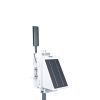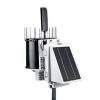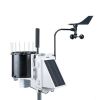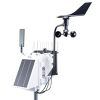KestrelMet 6000 Wireless Weather Stations
Features
- Measures key weather parameters with wireless Wi-Fi or cellular communication
- Optional leaf wetness, solar irradiance, and soil moisture sensors
- First year of cellular data plan is included at no additional cost
- Expedited repair and warranty service
- Lifetime technical support
- More
Overview
The KestrelMet 6000 is a reliable cost-effective all-in-one professional weather station for commercial, industrial, educational, and research applications. Easily deployable and remote, the KestrelMet arrives pre-assembled for fast set up and frustration-free installation. Cellular versions of the KestrelMet 6000 include a low-cost cellular plan with the first year free.
Mounting Options
Choose between the Mono Mount Kit or the Tripod Mount Kit to best fit research needs. Both options offer quick installation and a secure mounting system. The Mono Mount can be used on a pitched or flat roof as well as a vertical surface such as a gable end. The Tripod can be used on flat terrain, on a flat roof, or on the ridge of a pitched roof.
Design
Solar radiation can cause measurement errors and reduce sensor accuracy. Shielding over the air temperature and relative humidity sensors and a 24-hour aspirated fan keep air moving constantly over the sensors. This results in a significant improvement in measurement accuracy versus passive-shielded weather stations with no aspiration fan.
*Note: cellular transmission is set at 15-minute intervals.
| Sensors | Accuracy (+/- | Resolution | Range | Notes |
| Wind Speed | larger of 5% or 1 mph between 1 to 57 mph | 0.1 mph 0.1 knot 0.1m/s 0.1 km/hr |
1 to 100 mph 1 to 86.9 knots 1 to 44.7 m/s 1 to 160.9 km/hr |
Wind speed is measured continuously and stored in station memory as a series of 2 second averages. The reported wind speed is the average over the 15 minute logging interval. The highest measured speed during the logging interval is reported as the gust value. |
| Wind Direction | 2° | 1° | 1° - 360° | Wind direction is measured continuously and stored in station memory as a series of 2 second averages. The reported wind direction is the average scalar direction over the 15 minute logging interval. The gust direction is the average scalar direction for the 2 second record corresponding to the gust value. |
| Temperature |
0.45° F |
0.1° F 0.1° C |
-40° to 140° F -40° to 60° C |
Temperature is measured once per minute. The reported temperature is the average value for the 15 minute logging interval. High and low temperatures are based on the 1-minute readings. |
| Relative Humidity | 1.5% between 0 - 80% | 1% | 0 to 100% | Humidity is measured once per minute. The reported humidity is the average value for the 15 minute logging interval. High and low RH are based on the 1-minute readings. |
| Absolute Pressure | 1.5 mbar/hPa 0.044 inHg 1.1 mmHg |
0.1 mbar/hPa 0.01 inHg 0.1 mmHg |
600 to 1100 mbar/hPa 17. 72 to 32.48 inHg 450.0 to 825.1 mmHg |
Pressure is measured once per minute. The reported pressure is the average value for the logging interval. High and low pressures are based on the 1-minute readings. |
| Rain Rate | 5% at 2"/hr | 0.01 in/hr 0.1 mm/hr |
0 to 7.8 in/hr | Rainfall is measured continuously in 0.2 mm increments (tipping bucket calibration volume) |
In The News
Three Decades of Research at Acton Lake
A multi-disciplinary team at Miami University, Ohio, has been studying the environmental change at Acton Lake for over three decades. Using three different NexSens buoys over this time, the team has an incredible archive of data that is helping build a picture of Acton’s past, present, and future. Until recently, a NexSens CB-50 buoy was used alongside other environmental monitoring at Acton Lake. In May 2025, the Miami team deployed a new XB-200 buoy , future-proofing their ongoing monitoring using real-time buoy systems. Acton Lake, a small hypereutrophic reservoir in southwest Ohio, covers 2.4km² and has a maximum depth of about 8m. The dam was built in 1956, and the lake has a large agricultural watershed.
Read MoreSource Water Monitoring in Albany, New York: Tracing Water Quality throughout Tributaries
Thousands of US cities pull their drinking water from natural source waters like reservoirs, rivers, and streams, making overall watershed health a key consideration for water providers. In Albany, New York, the Albany Department of Water and Water Supply delivers drinking water to over 100,000 residents as well as monitors and manages the larger drinking water supply watershed. Hannah Doherty, Environmental Specialist at the Albany Department of Water and Water Supply , spends her days working with a small team to monitor the drinking supply and the connected water bodies. Doherty explains, “We’re the first to encounter the water that ends up being the drinking water.
Read MoreWildfire Prevention in the Sierra Nevada Region with the Yuba Watershed Institute
Though recent wildfires have sparked new conversations about wildfire management and response, groups like the Yuba Watershed Institute have been monitoring the forests and water resources of the Sierra Nevada region for decades, managing approximately 5,000 acres of land with the Bureau of Land Management (BLM) and about 7,000 acres in private land partnerships. The goal of the Institute is to work with local communities and land agencies to improve watershed and forestry management through informed practices and public outreach. The goals of the Yuba Watershed Institute are three-fold: Improve the ability of fire suppression agencies like the California Department of Forestry and Fire Protection ( CAL FIRE ) and the US Forest Service.
Read More


























